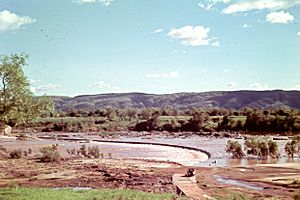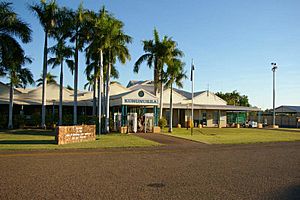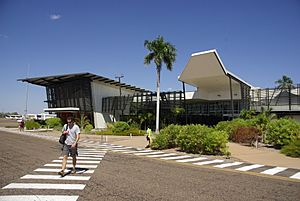Kununurra, Western Australia facts for kids
Quick facts for kids KununurraWestern Australia |
|||||||||
|---|---|---|---|---|---|---|---|---|---|

Kununurra in summer from Hidden Valley National Park lookout
|
|||||||||
| Established | 1961 | ||||||||
| Postcode(s) | 6743 | ||||||||
| Elevation | 47 m (154 ft) | ||||||||
| Area | [convert: needs a number] | ||||||||
| Location | |||||||||
| LGA(s) | Shire of Wyndham-East Kimberley | ||||||||
| State electorate(s) | Kimberley | ||||||||
| Federal Division(s) | Durack | ||||||||
|
|||||||||
Kununurra is a town in the far north of Western Australia. It is located at the eastern edge of the Kimberley region. The town is about 45 kilometers (28 miles) from the border with the Northern Territory.
Kununurra was created to support the Ord River Irrigation Scheme. This project helps to water farms in the area. The town is built on the traditional lands of the Miriwoong people, who are an Aboriginal Australian group.
It is the biggest town in Western Australia north of Broome. The closest town is Wyndham, which is 100 kilometers (62 miles) away. Kununurra is 3,040 kilometers (1,889 miles) from Perth by road.
The town is surrounded by beautiful hills and ranges in the north-east Kimberley. It has a lot of fresh water, thanks to the Ord River Diversion Dam and the main Ord River Dam. Over the years, different crops have been grown here. Tourism and mining are also very important to the town's economy.
Contents
History of Kununurra
People have thought about farming along the Ord River since the 1800s. Early maps from 1887 even showed an area for growing sugar cane, but it was never used. The land was mainly used for raising animals until 1960.
Kununurra was built on land that used to be part of the Ivanhoe Station cattle farm. This happened before 1961. The town was planned to support the Ord River Irrigation Area, which started as the Ord River Project. Work on the project began in 1959.
Lake Kununurra is a part of the Ord River valley that was flooded. It used to be called Carlton Reach. In 1959, workers started drilling and blasting to build the Ord River Diversion Dam. This dam has twenty flood gates. Queen Elizabeth II and Prince Philip visited the dam in March 1963, just before it was finished. It was officially opened by Prime Minister Robert Menzies on July 20, 1963. He said Kununurra and the Ord River Irrigation Area were "the most exciting place in Australia."
Many farmers in the Ord River Irrigation Area live in Kununurra. However, some now live on their farms. Other small communities and farms are also found within 50 kilometers (31 miles) of the town. These include Aboriginal communities and the Frank Wise Institute of Tropical Agriculture. This institute started in 1945 as the Kimberley Research Station. It was one of the first serious attempts at tropical farming on the Ord River.
The Ord River project involved building dams to save water and use it to water about 750 square kilometers (290 square miles) of land. By 1966, there were 31 farms on the Ord River plains. In 1968, the second part of the project began. This was the building of the Ord River Dam, also called the "Top Dam." This dam created Lake Argyle.
The main Ord River Dam was finished in 1972. It is located 55 kilometers (34 miles) upstream from Kununurra. Prime Minister William McMahon officially opened it on June 30, 1972. He said it marked the start of "Ord Stage II." The dam flooded the land of Argyle Downs station, which was the home of the pioneering Durack family.
Before Lake Argyle filled up, stones from the original Argyle Downs homestead were moved. They were used to rebuild the homestead near the dam site. This became the Argyle Downs Homestead Museum.
The Kununurra post office opened on September 1, 1960.
What Kununurra Means
The name Kununurra comes from the English way of saying the Miriwoong word Goonoonoorrang (or Gananoorrang). This word means "river." Many people mistakenly think it means "Meeting of Big Waters" or "Big River."
It is likely that "Kununurra" was the Miriwoong name for this part of the Ord River. The Ord River flows for hundreds of kilometers from the south. Different Aboriginal language groups probably had their own names for the parts of the river that passed through their lands.
In 1943, a type of soil found in the area was named "Cununurra Clay." So, "Cununurra" was suggested as a town name in 1960. However, a postal official worried it sounded too much like "Cunnamulla" in Queensland. To avoid confusion, they decided to use "K" instead of "C." This also made it fit with other East Kimberley place names like Kalumburu. The name was officially chosen just days before the town was made official on February 10, 1961.
People in Kununurra
Kununurra has a population that changes throughout the year. Many people, like tourists and farm workers, come and go. If you include people living on nearby farms and communities, the population can reach around 7,000. During the dry season (April to September), when many tourists and farm workers arrive, the population can go up to about 10,000.
According to the 2016 census, there were 5,308 people living in Kununurra.
- About 22.9% of the people were Aboriginal and Torres Strait Islander.
- Most people (71.8%) were born in Australia. The next most common birthplaces were England (3.6%) and New Zealand (2.1%).
- Most people (76.4%) spoke only English at home. About 2.2% spoke Miriwoong.
- The most common religions were No Religion (38.8%) and Catholic (19.0%).
Geography and Climate
The area around Kununurra has many beautiful natural spots. These include Valentine Spring, Black Rock Creek, and Middle Springs. There are also many other waterfalls and swimming holes. Popular places for fishing include Ivanhoe Crossing, the Diversion Dam, and parts of the Dunham and Ord Rivers.
The town is near where the Ord and Dunham River meet. Lake Argyle, Australia's largest artificial lake, is 72 kilometers (45 miles) by road from the town. It covers over 100 square kilometers (39 square miles).
Kununurra is part of an important area for birds called the Ord Irrigation Area Important Bird Area. This area is special because it is home to many wild birds, especially finches.
Kununurra's Climate
Kununurra has a semi-arid climate, which means it's usually hot and dry. It has two main seasons: a wet season and a dry season. The average rainfall each year is about 800 millimeters (31 inches).
The dry season, from April to September, is the best time to visit. It's not as hot or humid, and roads and parks are easier to access. In August, it almost never rains.
The "build-up" season, from October to December, is very hot and humid. This often leads to amazing thunderstorms with lots of lightning over the Kimberley landscape. These storms don't bring much rain, but the lightning can start bushfires.
The summer monsoon season, from January to March, brings heavy rain. This can cause roads and national parks to close. Days are cloudy and hot, with frequent heavy downpours.
| Climate data for Kununurra (1965−1986) | |||||||||||||
|---|---|---|---|---|---|---|---|---|---|---|---|---|---|
| Month | Jan | Feb | Mar | Apr | May | Jun | Jul | Aug | Sep | Oct | Nov | Dec | Year |
| Record high °C (°F) | 43.9 (111.0) |
42.2 (108.0) |
40.5 (104.9) |
39.5 (103.1) |
38.0 (100.4) |
36.7 (98.1) |
36.4 (97.5) |
39.4 (102.9) |
41.0 (105.8) |
43.6 (110.5) |
45.1 (113.2) |
44.6 (112.3) |
45.1 (113.2) |
| Mean daily maximum °C (°F) | 36.4 (97.5) |
35.5 (95.9) |
35.4 (95.7) |
35.5 (95.9) |
32.9 (91.2) |
30.5 (86.9) |
30.3 (86.5) |
33.6 (92.5) |
36.4 (97.5) |
38.3 (100.9) |
38.8 (101.8) |
38.0 (100.4) |
35.1 (95.2) |
| Mean daily minimum °C (°F) | 25.2 (77.4) |
24.9 (76.8) |
24.1 (75.4) |
21.4 (70.5) |
19.1 (66.4) |
15.9 (60.6) |
15.0 (59.0) |
17.4 (63.3) |
20.8 (69.4) |
23.7 (74.7) |
25.4 (77.7) |
25.7 (78.3) |
21.6 (70.9) |
| Record low °C (°F) | 19.6 (67.3) |
19.0 (66.2) |
16.1 (61.0) |
12.2 (54.0) |
9.6 (49.3) |
7.7 (45.9) |
4.8 (40.6) |
9.2 (48.6) |
10.6 (51.1) |
15.0 (59.0) |
17.2 (63.0) |
19.1 (66.4) |
4.8 (40.6) |
| Average rainfall mm (inches) | 196.6 (7.74) |
213.0 (8.39) |
136.2 (5.36) |
21.2 (0.83) |
10.0 (0.39) |
3.9 (0.15) |
1.3 (0.05) |
0.0 (0.0) |
2.8 (0.11) |
25.5 (1.00) |
70.9 (2.79) |
105.3 (4.15) |
786.7 (30.96) |
| Average rainy days (≥ 0.2mm) | 14.8 | 14.8 | 10.2 | 2.5 | 1.0 | 0.2 | 0.2 | 0.0 | 0.6 | 3.5 | 6.8 | 10.4 | 65 |
| Average relative humidity (%) | 60 | 65 | 57 | 40 | 35 | 33 | 30 | 31 | 31 | 37 | 43 | 51 | 43 |
| Climate data for Kununurra Aero (1991−2020) | |||||||||||||
|---|---|---|---|---|---|---|---|---|---|---|---|---|---|
| Month | Jan | Feb | Mar | Apr | May | Jun | Jul | Aug | Sep | Oct | Nov | Dec | Year |
| Record high °C (°F) | 43.1 (109.6) |
41.7 (107.1) |
43.0 (109.4) |
40.4 (104.7) |
38.5 (101.3) |
37.4 (99.3) |
36.5 (97.7) |
38.5 (101.3) |
41.1 (106.0) |
43.9 (111.0) |
45.1 (113.2) |
45.3 (113.5) |
45.3 (113.5) |
| Mean daily maximum °C (°F) | 35.9 (96.6) |
35.2 (95.4) |
35.8 (96.4) |
35.5 (95.9) |
33.0 (91.4) |
30.5 (86.9) |
30.8 (87.4) |
32.8 (91.0) |
36.8 (98.2) |
38.8 (101.8) |
39.1 (102.4) |
37.3 (99.1) |
35.1 (95.2) |
| Mean daily minimum °C (°F) | 25.1 (77.2) |
24.7 (76.5) |
24.2 (75.6) |
21.8 (71.2) |
18.6 (65.5) |
15.7 (60.3) |
14.9 (58.8) |
15.5 (59.9) |
19.8 (67.6) |
23.4 (74.1) |
25.2 (77.4) |
25.5 (77.9) |
21.2 (70.2) |
| Record low °C (°F) | 18.8 (65.8) |
19.5 (67.1) |
16.1 (61.0) |
11.9 (53.4) |
8.6 (47.5) |
6.7 (44.1) |
6.4 (43.5) |
6.1 (43.0) |
9.3 (48.7) |
13.9 (57.0) |
16.4 (61.5) |
19.0 (66.2) |
6.1 (43.0) |
| Average rainfall mm (inches) | 209.2 (8.24) |
216.0 (8.50) |
143.3 (5.64) |
29.5 (1.16) |
6.8 (0.27) |
3.0 (0.12) |
1.4 (0.06) |
0.1 (0.00) |
5.2 (0.20) |
23.4 (0.92) |
58.5 (2.30) |
142.6 (5.61) |
839 (33.02) |
| Average rainy days | 15.7 | 15.0 | 11.0 | 3.0 | 1.2 | 0.5 | 0.3 | 0.1 | 0.7 | 3.8 | 7.2 | 12.3 | 70.8 |
| Average relative humidity (%) | 60 | 64 | 52 | 37 | 30 | 28 | 24 | 23 | 29 | 32 | 40 | 53 | 39 |
Farming in Kununurra

Important farm activities in Kununurra include growing melons and mangoes. In the past, sugar cane was also a major crop. Farmers are now growing Indian sandalwood, which takes longer to grow but can be more profitable.
Other crops grown here have included cotton, safflower, and rice. Rice was actually the first crop planted on the Pilot Farm in 1960, and it is being tried again. Kununurra has a melon picking season, which brings many farm workers to the area.
Tourism is also a big industry. Many tour operators show visitors the beautiful scenery of the Ord River, Lake Argyle, the Diversion Dam, and other local spots. This includes the nearby Bungle Bungle Range.
Local Media
Since 1980, Kununurra has been home to the Kimberley Echo newspaper. The local radio station, 6WR, broadcasts across the Kimberley area. You can listen to it on different frequencies. 6WR also streams live online and is available in remote parts of Australia. Another station, Reach Beyond Australia, broadcasts from Kununurra on shortwave radio.
Fun Things to Do
Kununurra has many local attractions. These include beautiful waterfalls, deep gorges, and scenic mountain ranges.
Aboriginal Arts Centres
Kununurra is home to important Aboriginal art centres.
Jirrawun Arts
Jirrawun Arts was an Indigenous Australian art centre. It started in Kununurra in 1998 and later moved to Wyndham in 2006. This centre was known for its contemporary Indigenous Australian artists from the eastern Kimberley region. Famous artists like Paddy Bedford and Freddie Timms worked there. Jirrawun Arts closed in 2010. Their artwork was shown in exhibitions in Melbourne and other places.
Waringarri Aboriginal Arts
Waringarri Aboriginal Arts is an Aboriginal art centre that celebrates the art and culture of the Miriwoong people. It was one of the first art centres in Western Australia to be fully owned by Indigenous people. It is also one of the oldest art centres in Australia that has been open continuously. The centre was updated in 2011.
At the centre, you can find artists' studios and galleries where artworks are sold. Visitors can also take cultural tours and watch performances. These activities help artists and their community earn money. Waringarri supports over 100 artists. They create painters, printmakers, wood carvers, boab engravers, sculptors, and textile art.
Getting Around
The East Kimberley Regional Airport, also known as Kununurra Airport, is about 3.7 kilometers (2.3 miles) west of the town center. During heavy wet seasons, the area can be cut off from important services and deliveries. The airport is very important for people and goods to get in and out of the region. It especially helps tourism and the local economy.
Town Facilities
Kununurra has many services and places for the community.
Legal Services
The Kununurra Courthouse opened on October 26, 2014. It has courtrooms for magistrates and juries. The building's design includes paintings by Aboriginal artists from Miriwoong country.
Education
East Kimberley College teaches students from kindergarten to year 12, with over 900 students. St Joseph's Primary School and Ngalangangpum School are two Catholic schools. For older students, there is a Western Australia North Regional Technical and further education (TAFE) campus.
Community Places
The Kununurra Leisure Centre is a community building for sports and fun activities. It has a 25-meter (82-foot) swimming pool.
Kununurra Neighbourhood House is a non-profit community center. It offers services and activities for people in Kununurra. These include family support, playgroups, and parenting programs. They also help with emergency relief and offer advice. The center hosts events like markets and workshops. It is open Monday to Friday.
The Kununurra Youth Hub is run by the Police Citizens Youth Club (PCYC). It is open daily for young people in the community.
Kununurra in Pop Culture
Kununurra has a Celebrity Tree Park. Many famous people have planted trees there. Baz Luhrmann planted a tree after filming much of his 2008 movie Australia near Kununurra.
Actress Nicole Kidman believed that the water in the area helped her get pregnant while filming. She said, "seven babies were conceived out of this film and only one was a boy. There is something up there in the Kununurra water because we all went swimming in the waterfalls, so we can call it the fertility waters now."
In 2007, Outdoor Australia magazine voted Kununurra the second best town in Australia for outdoor adventures.
See also
 In Spanish: Kununurra para niños
In Spanish: Kununurra para niños







